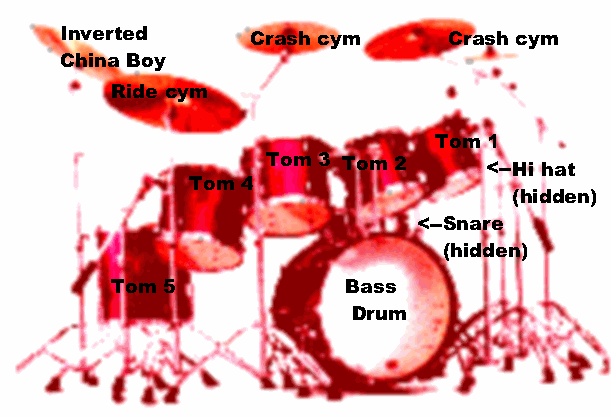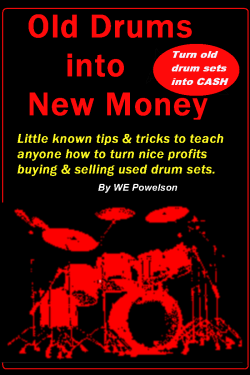


This web page has been setup especially for the very young students who may never have seen, or sat behind a real drumset . . .

We normally play on top of the hi-hat with our right hand . . . while the two cymbals are closed together. Most (many) of the beats in my course will have you playing on top of a closed hi-hat with your right hand. Drummers tend to play on top of a closed hi-hat . . . when the singer of the band is singing. It helps us to play quieter! Singers usually don't like too much noise coming from the drummer during the softer parts of a song . . .(HH)
Crash cymbals are usually placed on adjustable stands by themselves but every drum set manufacturer may try to come up with many, many different types of stands to make their drum sets seem better than drum sets made by the competition. (Crash)
There is no specific size or number of drums that make up a complete drum set. You may have as many tom toms or cymbals as you wish. Some drummers may use two bass drums. We all like to try to be different. The more drums we have, the more tonal variations we have to choose from as we play. More is better . . . if you have the money . . .
BUT;
For learning purposes . . . we can get by with just a Bass, Snare and maybe one
cymbal. This would be the absolute MOST BASIC drum set. Usually
it is best if we can start out on a set with two or three Tom-toms, a Hi-hat,
Ride Cymbal, a Crash and (of course) a Bass Drum.
The following lessons will get more into detail about when and what you should buy, plus how to assemble and tune your drums, once you have them at home.
BEFORE you get all crazy, buying drums and spending unnecessary money . . . LISTEN UP!
Do you have an aptitude for drumming?
Can and will you study?
Then prove it right now! I'll have you playing and jamming along with approximately 50 million songs in as little as 30 minutes, IF you have the aptitude, and if you have what it takes. I'LL TEACH YOU RIGHT NOW, AT NO COST!
No drums or sticks necessary! Start playing RIGHT NOW! I'll explain how to overcome the dilemma of having NO DRUMS, as we go! Start learning to play . . . right now! THEN BUY DRUMS!
So . . . Do it! Prove to yourself that you have what it takes, right this minute. Start here and don't stop until you are jamming with half the songs on the radio! (It will only take approximately 30 minutes or less and you will become hooked on drumming . . . FOR LIFE.)
You can begin without dropping a penny! I won't even ask for your name or e-mail address. When I say "Free", I really do mean, "FREE".
MANY STUDENTS HAVE BEEN ASKING THIS NEXT QUESTION:
Can the inexpensive drum pads for X-BOX, Wii, DRUM HERO, etc., be used for turning your gaming skills into real talent? The answer is absolutely, YES! So, feel free to hook them up and use them.
Also; you can build your own Practice Drum Set rig. at minimal cost. I started on a practice rig that was very much like this one. To e-mail me Click here. (See) 'About'. Get my e-mail address; drop me a note and ask any question. I'll always try to help you!By the time you have completed the above four lessons, you will know exactly what all the drums look like, where they should be placed and what they should sound like.
![]() Copyright
Bill Powelson 1965-1994-2008-2014 @ all rights reserved.
Copyright
Bill Powelson 1965-1994-2008-2014 @ all rights reserved.

![]()
Musical Time - Finite to Infinity:
Finite to Infinity:
Learn to easily jam and play music comfortably within any odd or even time signature. This material isn't currently taught in music-theory classes, yet it is simple enough for grade-school students. Discover more than 18 quintillion unique and different (modern music) song-beat structures.Discover the (lost) 500 year-old enigmatic secrets hidden within the current time-signature system. Seven short mesmerizing and easy-to-follow lessons will lead you quickly and easily towards (musical-time) guru status. You will learn to visualize (read, write or feel) the existence This should lead directly to the e-book.

This very informative little booklet will amaze you with hundreds of valuable tips and insider secrets! HOW TO: Purchase old/used drumsets for pennies and resell them for decent profits.